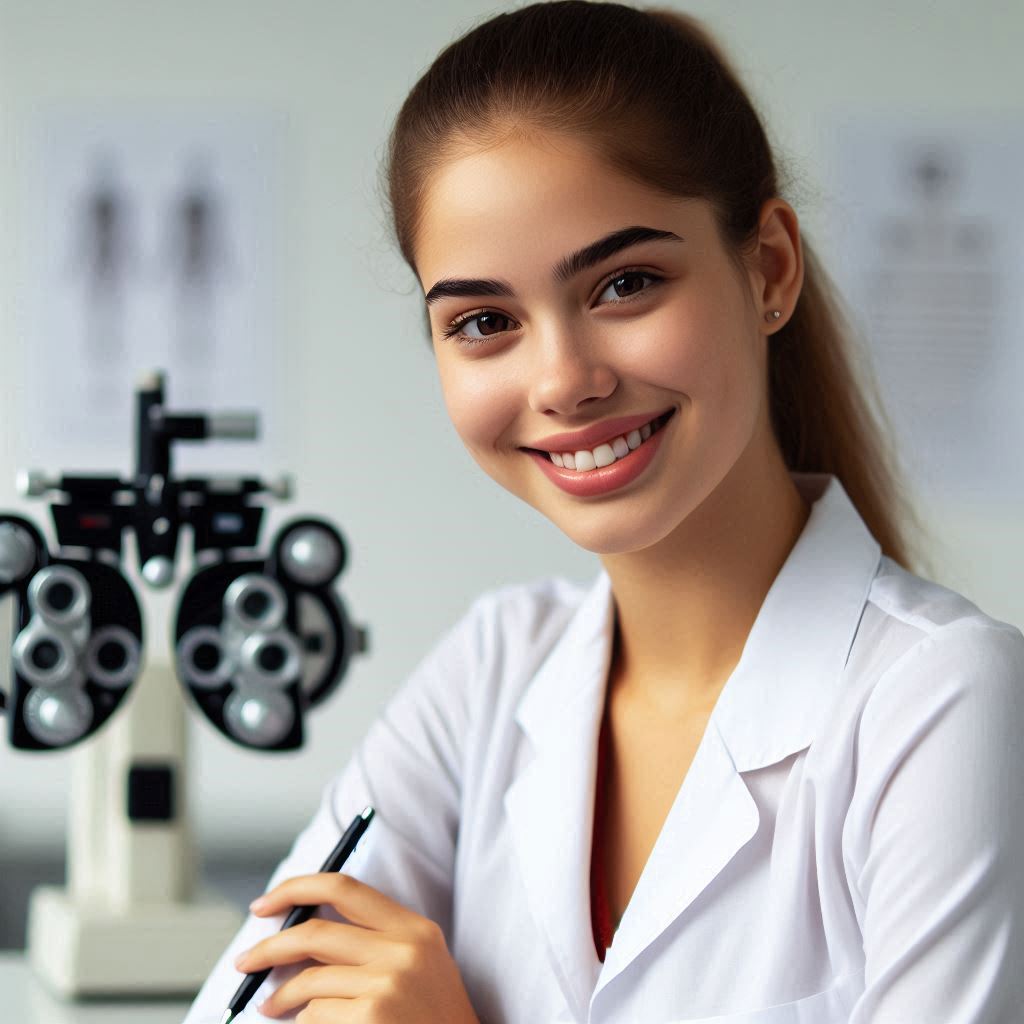Introduction
Optometrists play a crucial role in diagnosing and treating various eye conditions.
Understanding Common Eye Conditions
- Myopia (Nearsightedness): Difficulty seeing objects far away.
- Hyperopia (Farsightedness): Struggle with close-up vision.
- Astigmatism: Blurred or distorted vision at all distances.
- Presbyopia: Loss of ability to focus on close objects.
- Dry Eye Syndrome: Insufficient tears to lubricate the eyes.
Diagnosis and Treatment
Optometrists conduct comprehensive eye exams to diagnose these conditions accurately.
They prescribe glasses or contact lenses to correct refractive errors.
For dry eyes, artificial tears or prescription medications may be recommended.
Optometrists also provide advice on lifestyle changes to manage certain conditions.
Importance of Regular Eye Exams
Early detection of eye conditions can prevent worsening of symptoms.
Regular eye exams help in monitoring changes in vision over time.
Optometrists can detect underlying health issues through eye exams.
Preventative care through routine exams can maintain overall eye health.
In a nutshell, optometrists play a vital role in diagnosing and treating common eye conditions.
Myopia (Nearsightedness)
Myopia, also known as nearsightedness, is a common eye condition that causes distant objects to appear blurry while close objects can be seen clearly.
Below are the key points to understand about myopia:
Definition and Causes
Myopia occurs when the eyeball is too long or the cornea is too curved, causing light rays to focus in front of the retina instead of on it.
Genetics play a significant role in the development of myopia, but environmental factors like excessive screen time can also contribute to its onset.
Symptoms and Impact on Vision
Common symptoms of myopia include squinting, eye strain, headaches, and difficulty seeing distant objects clearly.
Untreated myopia can lead to more serious complications such as retinal detachment, glaucoma, or macular degeneration.
Treatment Options
- Glasses: Prescription eyeglasses with concave lenses help to correct nearsightedness by refracting light properly onto the retina.
- Contact Lenses: Soft or rigid gas-permeable contacts offer an alternative to glasses for individuals with myopia.
- Refractive Surgery: Procedures like LASIK or PRK reshape the cornea to improve vision and reduce or eliminate the need for corrective eyewear.
It is essential to visit an optometrist for a comprehensive eye exam if you suspect you have myopia to receive an accurate diagnosis and appropriate treatment.
Read: Optometrist vs. Ophthalmologist: Key Differences Explained
Hyperopia (Farsightedness)
Definition and Causes
Hyperopia, commonly known as farsightedness, is a refractive error where distant objects can be seen more clearly than up-close objects.
This condition occurs when the eyeball is too short or the cornea has too little curvature.
Transform Your Career Today
Unlock a personalized career strategy that drives real results. Get tailored advice and a roadmap designed just for you.
Start NowAs a result, light entering the eye focuses behind the retina instead of directly on it.
Some common causes of hyperopia include genetics, where individuals inherit a predisposition to farsightedness.
Age can also play a role, as the lens of the eye loses flexibility with time, making it harder to focus on close-up objects.
Symptoms and Impact on Vision
Individuals with hyperopia may experience symptoms such as difficulty focusing on close-up tasks like reading or using a computer.
This can lead to eye strain, headaches, and even blurred vision. While distant vision may be clear, near vision is compromised.
Untreated hyperopia can impact daily activities and overall quality of life.
Tasks that require near vision, such as reading or sewing, may become challenging and frustrating.
This can affect productivity and lead to avoidance of activities that require close visual attention.
Treatment Options Similar to Myopia
Optometrists offer various treatment options for hyperopia, similar to those for myopia (nearsightedness).
Glasses or contact lenses with specific prescriptions can help correct the refractive error, allowing individuals to see clearly at all distances.
Refractive surgeries like LASIK or PRK are also popular choices for correcting hyperopia.
These procedures reshape the cornea, adjusting its curvature to ensure that light focuses directly on the retina, improving vision for both near and distant objects.
Optometrists may also recommend vision therapy exercises to strengthen eye muscles and improve focusing abilities.
These exercises help individuals with hyperopia enhance their visual acuity and reduce symptoms of eye strain and discomfort associated with farsightedness.
In fact, hyperopia, or farsightedness, is a common refractive error that can be effectively treated by optometrists through various options such as glasses, contact lenses, refractive surgeries, and vision therapy.
By addressing the underlying causes of hyperopia and correcting the refractive error, individuals can enjoy clear vision and improved quality of life.
Read: Day in the Life of an Optometrist: Duties and Challenges
Astigmatism
Astigmatism is a common refractive error caused by an irregularly shaped cornea or lens.
It can be hereditary or acquired due to eye injury, surgery, or keratoconus.
Symptoms of astigmatism include blurred or distorted vision, eye strain, and headaches.
Transform Your Career Today
Unlock a personalized career strategy that drives real results. Get tailored advice and a roadmap designed just for you.
Start NowPeople with astigmatism may experience difficulty driving at night or reading small print.
Impact on Vision
- Difficulty seeing clearly at any distance
- Straining eyes to focus on objects
- Poor night vision
Astigmatism may also cause issues with depth perception and peripheral vision.
Treatment Options
Corrective lenses are the most common treatment for astigmatism.
- Eyeglasses with cylindrical lenses
- Contact lenses, including toric lenses
Refractive surgery, such as LASIK or PRK, can also correct astigmatism permanently.
Orthokeratology involves wearing special contact lenses at night to reshape the cornea.
Regular eye exams are essential to monitor astigmatism and adjust the prescription as needed.
Read: Top Skills Needed for a Successful Optometry Career

Presbyopia
Presbyopia is a common age-related condition that affects the eye’s ability to focus on close objects. It typically occurs around the age of 40 and worsens with time.
Definition and Causes
Presbyopia is caused by the gradual loss of elasticity in the lens of the eye.
This loss of flexibility makes it difficult for the eye to change focus from far to near objects.
It is a natural part of the aging process and affects nearly everyone as they get older.
Symptoms and Impact on Near Vision
The most common symptom of presbyopia is the need to hold reading materials at arm’s length.
Other symptoms include eyestrain, headaches, and difficulty seeing in low light.
Presbyopia can impact daily activities such as reading, using a computer, or sewing.
Treatment Options
Reading glasses are a simple and effective way to correct presbyopia.
Progressive lenses offer a smooth transition from distance to near vision.
Bifocals have two distinct optical powers, one for distance and one for near vision.
It’s essential to have regular eye exams to monitor and address any changes in your vision, including presbyopia.
Your optometrist can help determine the best treatment option for your specific needs.
Read: How to Become an Optometrist: Education and Training Guide
Transform Your Career Today
Unlock a personalized career strategy that drives real results. Get tailored advice and a roadmap designed just for you.
Start NowDry Eye Syndrome
Definition and causes
Dry Eye Syndrome is a common condition where the eyes do not produce enough tears or the right quality of tears.
This can lead to discomfort and potential damage to the surface of the eyes.
Causes include aging, certain medications, environmental factors like dry air or wind, and underlying health conditions such as rheumatoid arthritis or Sjögren’s syndrome.
Symptoms
Symptoms of Dry Eye Syndrome often include irritation, redness, a gritty sensation, and blurred vision, especially after reading or using digital devices for extended periods.
Patients may experience discomfort exacerbated by factors like smoke or wind. These symptoms can significantly impact daily activities and quality of life.
Treatment options including artificial tears, prescription medications, and lifestyle changes
Treatment options for Dry Eye Syndrome vary depending on the severity and underlying causes.
Initially, optometrists may recommend over-the-counter artificial tear drops to lubricate the eyes and reduce discomfort.
For more severe cases, prescription eye drops that increase tear production or improve tear quality may be prescribed.
Lifestyle changes such as using a humidifier, avoiding smoke, or taking breaks during prolonged screen use can also help manage symptoms.
In some instances, optometrists may suggest blocking tear ducts to reduce tear drainage and keep the eyes moist.
This can be done with tiny punctal plugs inserted into the tear ducts.
Managing underlying conditions contributing to dryness, like adjusting medications or treating systemic diseases, is also crucial.
Optometrists play a vital role in diagnosing and managing Dry Eye Syndrome, providing personalized treatment plans tailored to each patient’s needs.
By addressing both symptoms and underlying causes, they aim to improve eye comfort and prevent long-term complications associated with chronic dryness.
Regular monitoring and adjustments to treatment help ensure ongoing relief and maintenance of eye health.
Glaucoma
Glaucoma is a common eye condition that affects millions of people worldwide.
It is a group of eye diseases that cause damage to the optic nerve, often as a result of increased pressure in the eye.
Definition and Causes
Glaucoma is typically caused by a buildup of fluid in the eye, which leads to increased pressure.
Other causes may include poor blood flow to the optic nerve, genetics, and certain medical conditions.
Symptoms and Impact on Vision
- Early stages of glaucoma may not have any noticeable symptoms.
- As the condition progresses, patients may experience blurred vision, eye pain, and even vision loss.
- Glaucoma can lead to permanent vision damage if left untreated.
Treatment Options
- Eye Drops: Medications in the form of eye drops can help reduce eye pressure and prevent further damage.
- Laser Therapy: Laser surgery can be used to improve the drainage of fluid in the eye, reducing pressure.
- Surgery: In more severe cases, traditional surgery may be recommended to create a new drainage channel in the eye.
Regular eye exams are essential for early detection and management of glaucoma.
Transform Your Career Today
Unlock a personalized career strategy that drives real results. Get tailored advice and a roadmap designed just for you.
Start NowIf you experience any symptoms or have a family history of the condition, be sure to consult with an optometrist for proper evaluation and treatment.
Conclusion
Optometrists can effectively treat a variety of common eye conditions.
From refractive errors like myopia and hyperopia to more serious conditions like glaucoma and cataracts, optometrists play a crucial role in preserving eye health.
It is important to seek professional help from an optometrist for proper diagnosis and treatment of eye conditions.
Optometrists have the knowledge and expertise to accurately diagnose eye issues and provide appropriate treatment options, including prescription eyeglasses, contact lenses, or referrals to ophthalmologists for more advanced care.
Regular eye exams are essential for early detection and management of eye conditions.
By scheduling routine appointments with an optometrist, individuals can maintain good eye health and prevent vision loss.
Optometrists are dedicated to helping patients achieve optimal vision and overall well-being through comprehensive eye care.
[E-Books for Sale]
The Big Book of 500 High-Paying Jobs in America: Unlock Your Earning Potential
$19.99 • 500 High-Paying Jobs • 330 pages
Explore 500 high-paying jobs in America and learn how to boost your career, earn more, and achieve success!
See All 500 High-Paying Jobs of this E-Book
1001 Professions Without a Degree: High-Paying American Jobs You Can Start Now
$19.99 • 1001 Professions Without a Degree • 174 pages
Discover 1001 high-paying jobs without a degree! Unlock career tips, skills, and success strategies for just $19.99!




